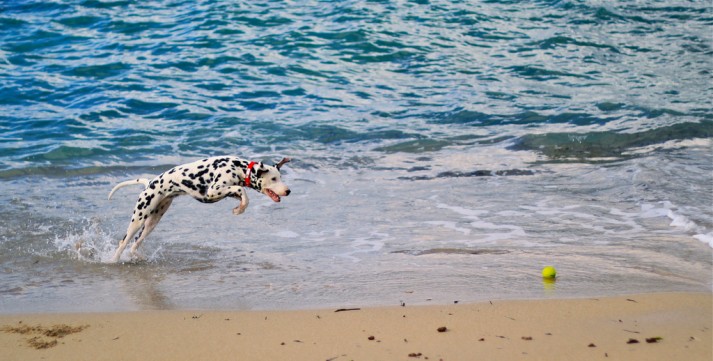This
post was originally published on
this siteOriginally posted at: http://www.nerdfitness.com/
This is a guest post from Camp NF instructor Jonathan Mead.
I’m no historian or anthropologist, but I don’t think it takes a rocket scientist to see that over time, we’ve come to move less and less thanks to amazing advances in technology.
Simply put, our bodies are capable of amazing things, but we no longer NEED to do these things in order to survive. How did this happen, and how has it changed us as a species?
- First, the agricultural revolution allowed people to specialize and outsource movement to farmers (the birth of the division of labor).
- Then, there was the industrial revolution, which allowed for even less movement with the advent of machines to do much of the work for us.
- Finally, the technological revolution made movement practically obsolete. A meal, book, even a date on OKCupid is just a click away. Hell, you can now order pizza by sending an emoji.
Although it’s not our fault we don’t HAVE to move much anymore, it IS our responsibility to address it. Our lives simply don’t require it any more – the Empire (boo!) took over and changed the way we live by removing ANY physical requirement from existence.
Unfortunately, this sets us up for disaster when we do try to move more often: when we go from sitting for 10-12 hours a day to trying to train martial arts or Parkour, playing kickball or even picking up groceries, it’s no wonder injuries are commonplace.
If you’re looking to improve your physical well-being, remain injury-free, and set yourself up to succeed with whatever form of fun activity you choose to get your heart racing, it’s time to start moving like we are genetically designed to move.
Let’s take a look how to master our body’s controls, and rebel against captivity.
Anti-fragility is your natural, primal state

Believe it or not, you grow stronger when you expose your body to chaos. The problem is, modern zoo living life has made everything very predictable, and much too comfortable.
This isn’t a surprise if you’ve ever seen the movie Madagascar: take an animal raised in temperature-controlled captivity, and compare them to an animal raised in the wild: which one do you think is better prepared to handle life in the jungle?
In Steve’s article on Becoming Antifragile, he talks about how some things grow stronger through unpredictability, breakdown and stress. It’s no surprise that our man-made habitat – traveling from couch to car to computer desk each day – has allowed our bodies to break down. Like in WALL-E, modern life has removed the “survival of the fittest” aspect from the human race, and thus we no longer to take care of ourselves physically to get food or shelter.
We need to reintroduce this element into our lives as much possible if we’re going to level up our bodies.
Think for a moment about how your joints and ligaments would develop:
- Option one: walking in an air conditioned gym on a treadmill at precisely 3.5 miles per hour.
- Option two: traversing a trail covered with rocks, dirt, mud and branches in your way. You might need to hop from rock to rock on all fours, crawl under a branch, and jump over the mud.
Because of the natural variability of terrain and your tasks for the day, your joints are going to be moved in many different ways, in many different angles. You’re forced to respond to the elements and constantly adapt.
Take away the unpredictability of life — like sitting in a chair all day, or never lifting anything heavier than 3 lbs — and you create weakness and vulnerability that can result in problems when you face any real world scenario that requires even a base level of physical fitness.
Disaster!
It sounds counterintuitive, but our bodies crave unpredictability and continuous stressors. Too much of the same pattern in our temperature-controlled, artificially lit, smoothed-edges lives, and we become increasingly vulnerable to injury and breakdown.
In fact, there has been a recent study that showed an increased chance of children developing peanut allergies when they are kept away from peanuts beginning at birth. This is why playing in the mud as a kid can actually be really beneficial for your body’s immune system development.
So get started, get uncomfortable, and start pushing your body outside of its “safe” zone. Get comfortable with being uncomfortable. Antifragility is the goal!
So, how do we fix this mess and start moving better?

Good question! The most important thing is to start exploring your body…no, not like that!
That’s next week’s article (kidding).
What I mean is research the way your body moves. Be curious!
Of course, it’s easy for me to say that, but a bit tougher to explain. You see, most of us have gotten so far away from this way of living, that we need a framework to get us back on track. If you’re somebody who struggles with lower back pain, despite all of modern life’s creature comforts, make sure you start implementing the below movements. Don’t set yourself up to suffer through inaction!
Here are two movements you can start with RIGHT NOW that every human should master:
Here’s the gist of the video:
- Squat DEEP! Believe it or not, an “ass to grass” squat is the natural human resting position, and it results in less lower back pain among indigenous people despite a lack of access to things like chairs. For people who don’t live in a civilized modern society, this is how they rest! So, how do you do it? Arrange your feet shoulder width apart and begin lowering yourself down, leading with your tailbone as if you’re feeling for a chair behind you. Keep lower until your thighs are touching your calves. Make sure your heels stay on the ground. Try to hold this position for as long as you can, even if it’s just for a few seconds, gradually working up to being able to hold for several minutes. Try it while watching TV, playing video games, or reading. Just do it (Desk jockeys – be sure to avoid hunching forward!).
- Hang out. Did you know that our shoulders are meant for us to hang? We evolved to be able to “hang out” on branches (just look at the way kids naturally hang and swing on the playground). It’s actually critical for the health of our spine and shoulders. If you can, mount a pullup bar in your doorway and spend 10-30 seconds hanging each time you go through. If your hands aren’t strong enough, use a bit of assistance by putting your feet on a chair.
Creating the habit of all-day movement

As you’ve probably guessed by now, the real benefit comes when we start to implement old-school movement throughout our modern lives. Our paleolithic ancestors were constantly moving and dealing with mother nature throwing chaos at them. They simply had no other choice but to continually move and adapt.
As Anthony Mychal points out, we send our bodies conflicting information all day long if we don’t actively work on it: if you stretch for 10 seconds (“Hey body! Being mobile and flexible is important!”), the other 86,390 seconds we’re saying “Hey body! Stretching isn’t important! In fact, sitting is!”
So, how can you make natural movement a lifestyle or a continual fixture in your day?
The key isn’t to pledge to move more and sit less, but to change your environment and your habits so that these changes become a natural part of your life, and we start to tip the scales back in favor of “move! squat! hang!”
Here are a few tips to get you started:
- Consider a standing desk. As this viral infographic proved, sitting is correlated with higher mortality rates. Most of us work on the computer these days, which creates a whole host of issues. One of the best ways to combat this is to create a standing desk. This can be accomplished with something as simple as a couple of boxes to put your monitor on (how I started out) or by investing in an adjustable height desk. (This is not to say to stand ALL day, which might have its own problems. The idea is that you’re moving more).
- Put a medicine ball and tennis ball under your desk. The medicine ball can be used to stretch your calves by placing your toes and the ball of your foot on the ball. And the tennis ball can be used to massage and stimulate your feet.
- Consider a cobblestone mat for your house. The more you vary the terrain you walk on, the more you stimulate your feet and create healthy unpredictability.
- Squat while you eat. This is a habit I recently started. I try to squat while I eat as much as possible. This definitely helps you if you have a low coffee table to eat at, similar to a low, Japanese-style dining table where you sit cross-legged. It’s how humans used to eat before the advent of chairs. Squatting also helps massage the internal organs and builds healthier, stronger knees.
- Put a pullup bar in your doorway, and hang every time you go through the door. Hanging and brachiating is a natural human pattern and our shoulder joints are designed for brachiation. Why hang? Hanging and swinging creates healthier shoulders. Aim for 30 seconds of passive hanging every time you go through your door.
These are just a few habits you can start implementing to incorporate more primal movement into your daily life.
where do I start?

The unsexy part of leveling up – especially with something like fundamental, foundational movement – is going back to the basics. By drilling these patterns into our day, our bodies adapt and thus build a solid foundation of awesome.
Remember, the second Rule of the Rebellion is that you’re in “for life.”
In other words, it’s not about diets, or short-term fixes. It’s about creating a new lifestyle.
To get back to your natural health you need to create a lifestyle of movement. One way to do this is to start with a habit.
To make it dead simple, I’ve created a 30-Day Squat Challenge. The absolute simplest, most basic place to start is with the squat. When you join the challenge (bring a nerdy friend for support!), you’ll get a quickstart guide to squatting. It covers the basics of form and increasing your flexibility in the squat. You’ll also get daily tips and inspiration.
The challenge is simple: For a total of 10 minutes a day, squat. You don’t need to do it all in one sitting squatting. It can and should be spread throughout the day.
Do it every day for 30 days to create the habit.
Here are some ideas to level up your squats:
- Squat while you’re waiting for the bus.
- Squat while you poop (seriously, there are a lot of benefits to this).
- Squat while you work on your laptop (use a 14-18″ box).
- Squat while you’re waiting in line (takes a bit more courage).
- Squat through your whole meal.
- Give away your couch and squat while watching television.
I challenge you to level up your natural strength:
Click here to take the 30-Day Squat Challenge.
My question for you: Where is your favorite unconventional place to drop into a squat? Share in the comments below.
-Jonathan
PS: Jonathan is one of our instructors at Camp Nerd Fitness this September!
###
photo source: Jordan Colley Visuals: bunny squat, pepe pont: dog jumping, imamon: toy caveman, m01229: museum caveman, David Boyle: Super Caveman









 We’re told time and again that in order to get healthy we need to let go of our “lower” instincts (e.g. conserving energy
We’re told time and again that in order to get healthy we need to let go of our “lower” instincts (e.g. conserving energy 




 For now classes are 6pm and 640pm at 2840 Wildwood st in the Boise Cloggers studio.
Book your class NOW!
click this ==>
For now classes are 6pm and 640pm at 2840 Wildwood st in the Boise Cloggers studio.
Book your class NOW!
click this ==>








